Mini-ITX boards combine 1.8GHz Atoms, optional Ion GPU
Mar 7, 2011 — by Eric Brown — from the LinuxDevices Archive — 31 viewsIEI released two Mini-ITX single board computers (SBCs) featuring the Intel Atom D525 or dual-core D525, both clocked at 1.8GHz. The KINO-PVN-D4251/D5251 and KINO-PV-D4252/D5252 both support up to 4GB 800MHz DDR3 memory, SATA and CompactFlash storage, PCI and PCIe expansion, dual gigabit Ethernet ports, plus USB and serial connectivity, while the KINO-PVN model adds an Nvidia GT218-Ion graphics processor.
Atom-based Mini-ITX boards have progressed considerably in recent years, along with the Intel Atom itself, to the point that you can get a dual-core 1.8GHz Atom, an Nvidia GT218-ION GPU, and loads of I/O all in a tidy 6.7 x 6.7-inch package. The presence of the Ion on the KINO-PVN-D4251/D5251 is the key difference between the two models, though the Ion-free KINO-PV-D4252/D5252 has two more serial ports, and there are some differences in operating temperature range.
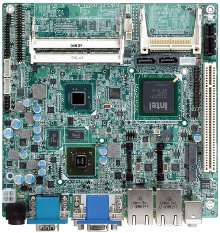
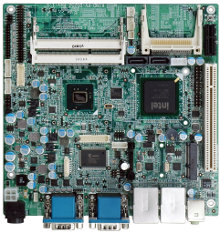
KINO-PVN-D4251/D5251 (left) and KINO-PV-D4252/D5252
(Click on either to enlarge)
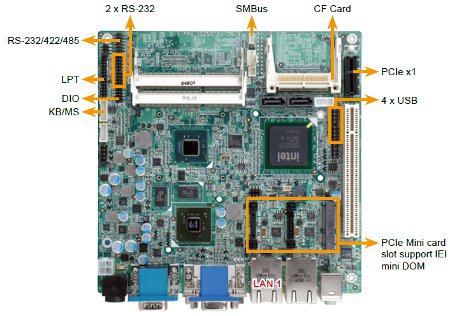
KINO-PVN detail
(Click to enlarge)
The KINO-PVN is also said to provide dual independent display support through various combinations of the provided VGA port, dual-link DVI-I interface, and HDMI port.
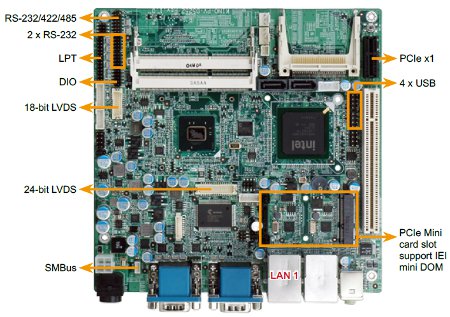
KINO-PV detail
(Click to enlarge)
Additional common features include dual gigabit Ethernet (PCIe) ports with ASF 2.0 support, eight USB 2.0 ports, one LPT port, and an audio port. While the KINO-PVN gets three RS-232 ports, the KINO-PV get two more ports for a total of five.
In addition, both models offer a configurable RS-232/422/485 port with auto flow control, says IEI. As shown in the images below, much of this I/O is extended to real-world ports on the coastline on both models.
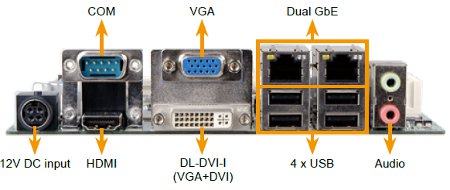
KINO-PVN coastline detail
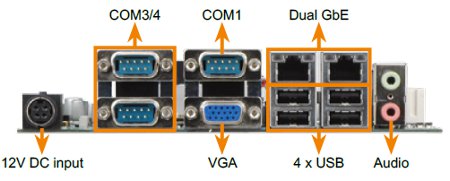
KINO-PV coastline detail
Features and specifications for the KINO-PV-D4252/D5252 and KINO-PVN-D4251/D5251 are said to include:
- Processor — Intel Atom D525 (dual-core) or Atom D425 (single-core), both @ 1.8GHz; ICH8M chipset; UEFI BIOS
- Graphics processor (KINO-PVN only) — Nvidia GT218-ION with 512MB DDR3
- Memory — up to 4GB DDR3 SDRAM (800MHz) via 2 x 204-pin SO-DIMMs
- Flash expansion — 1 x Compact Flash Type II slot
- Storage — 2 x SATA (3Gbps) ports supporting over 2.2TB when using 64-bit OS
- Expansion:
- 1 x PCI slot
- 1 x PCIe x1
- 1 x PCIe mini-card (PCIe + USB + SATA signal) supporting IEI mini DOM
- Display (KINO-PV):
- Analog CRT up to 2048 x 1536
- CRT hot plug support
- 18-bit single-channel LVDS up to 1366 x 768 or 1024 x 768
- 24-bit dual-channel LVDS (Novatek 68667UFG) at up to 1920 x 1080
- Display (KINO-PVN):
- Dual display support for HDMI+VGA, HDMI+DVI , VGA+DVI, VGA+VGA (via DVI to VGA adapter)
- Analog CRT support up to 2048 x 1536
- CRT hot plug support
- Dual Link DVI-I at up to 2560 x 1600
- HDMI at up to 1080p
- Ethernet — 2 x gigabit Ethernet (Realtek RTL8111E) via PCIe; LAN1 with ASF2.0 support
- Other I/O:
- 1 x LPT
- 1 x KB/MS (via pin header)
- 2 x SATA (3Gbps)
- 8 x USB 2.0
- 5 x RS-232 (KINO-PV); 3 x RS-232 (KINO-PVN)
- 1 x RS-232/422/485 with auto flow control
- 8-bit digital I/O (4-bit input/4-bit output)
- Super I/O (Fintek F81865)
- SMBus (1 x 4-pin wafer connector)
- Audio — Realtek ALC 888 HD codec
- Other features — watchdog
- Power:
- 12V, AT/ATX power mode
- 1 x external DIN 4-pin DC jack
- 1 x internal 2×2-pin connector
- 12V typ. consumption @ 3.44A (Atom D525 1.8GHz with 2GB DDR3)
- 12V typ. consumption @3.11A (Atom D425 1.8GHz with 2GB DDR3)
- Fan — 1 x 4-pin CPU fan connector; 1 x 3-pin system fan
- Operating temperature:
- KINO-PV with free air on D525 — -4 to 140 deg. F (-20 to 60 deg. C)
- KINO-PV with free air on D525 — -4 to 149 deg. F (-20 to 65 deg. C)
- KINO-PV with forced air on D525/D425 — -4 to 158 deg. F (-20 to 70 deg. C
- KINO-PVN — 14 to 140 deg. F (-10 to 60 deg. C); type not specified
- Dimensions - 6.7 x 6.7 inches (170 x 170mm); Mini-ITX
IEI Technology also offers a somewhat similar, but more I/O limited ECW-281B-D525 fanless box PC that ships with the Atom D525.
Availability
The KINO-PVN-D4251/D5251 and KINO-PV-D4252/D5252 appear to be available now, at an unstated price. More information may be found on IEI's KINO-PVN page and KINO-PV page, respectively.
This article was originally published on LinuxDevices.com and has been donated to the open source community by QuinStreet Inc. Please visit LinuxToday.com for up-to-date news and articles about Linux and open source.